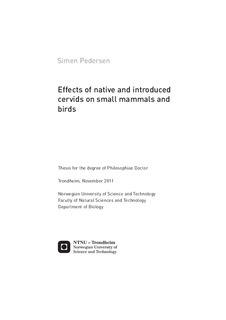| dc.contributor.author | Pedersen, Simen | nb_NO |
| dc.date.accessioned | 2014-12-19T13:12:23Z | |
| dc.date.available | 2014-12-19T13:12:23Z | |
| dc.date.created | 2012-03-14 | nb_NO |
| dc.date.issued | 2011 | nb_NO |
| dc.identifier | 512518 | nb_NO |
| dc.identifier.isbn | ISBN 978-82-471-3240-1 (printed ver.) | nb_NO |
| dc.identifier.isbn | 978-82-471-3241-8 (electronic ver.) | nb_NO |
| dc.identifier.uri | http://hdl.handle.net/11250/244980 | |
| dc.description.abstract | Cervids are a widespread family of ungulates, native to the Americas, Europe and Asia and introduced to Australia. Densities of cervids have increased in North America, Europe and Japan during the last couple of decades, due to changes in land use, reduced hunting, lack of large carnivores and changes in management practices. Where they occur at high densities, native and introduced cervids may have profound effects on vegetation, causing knock-on effects on other taxa. Cervids are in some instances managed towards changing the local distribution through supplemental feeding. These supplemental feeding stations are causing localized areas of high cervid abundance in the landscape, and may have effects on plants and animal species.
In this thesis I investigate how high cervid densities and the practice of supplemental feeding impact birds and small mammals through effects on; 1) food resources, and 2) habitat structure.
Utilizing a simulated moose (Alces alces) browsing experiment, I tested how varying moose densities and varying site productivity affects vole preference for bilberry. I found that voles preferred unbrowsed bilberry at low productivity sites, while they preferred lightly browsed bilberry at high productivity sites, I was however unable to explain the preference pattern with the chemical composition of the bilberry. However, moose do impact vole food preferences and this could, depending on the productivity of the site, potentially affect food selection and population dynamics over large geographical areas.
Moose browsing pressure and nutrient input gradually decline with distance from supplemental winter feeding stations. I utilized this gradient to test how moose activity affects reproduction in pied flycatchers (Ficedula hypoleuca) and great tits (Parus major). The two species showed contrasting responses to moose feeding stations, great tits preferred to nest away from feeding stations where they showed higher feeding frequency and also produced more fledglings compared to close to feeding stations. Pied flycatchers on the other hand preferred to nest close to feeding stations where they had higher feeding frequency and fledgling mass was higher compared to further away. Hence, for both species moose browsing is affecting food availability that subsequently affects reproductive performance.
Moose supplemental feeding stations also changed the habitat for small mammals from dwarf shrub dominated to grass and forb dominated. This did not have any effect on reproductive performance of the small mammals, but it did affect species composition along a gradient from the feeding stations. There was higher abundance of Microtus spp. and common shrews (Sorex araneus) close to feeding stations, while bank voles (Myodes glareoleus) had higher abundance away from feeding stations, the latter however was not statistically significant.
Small mammals in Australian coastal heath were generally negatively associated with introduced rusa deer (Cervus timorensis), however one species responded positively to historical densities of rusa deer. It was however not possible to confirm these effects as being due to changes in habitat structure for the small mammals. However they may be explained by qualitative changes in the vegetation or alternatively by direct effects of deer through trampling or predation.
Cervids and their management have an impact on other fauna, however the effects vary depending on small mammal and bird species. The effects of cervids also depend on the habitat requirements and foraging preferences of the small mammals and birds. Effects may be mediated through both food resources and habitat structure and are dependent on site productivity and cervid density. | nb_NO |
| dc.language | eng | nb_NO |
| dc.publisher | Norges teknisk-naturvitenskapelige universitet, Fakultet for naturvitenskap og teknologi, Institutt for biologi | nb_NO |
| dc.relation.ispartofseries | Doktoravhandlinger ved NTNU, 1503-8181; 2011:328 | nb_NO |
| dc.relation.haspart | Pedersen, Simen; Nilsen, Erlend B.; Andreassen, Harry P.. Moose winter browsing affects the breeding success of great tits. Ecoscience. (ISSN 1195-6860). 14(4): 499-506, 2007. <a href='http://dx.doi.org/10.2980/1195-6860(2007)14[499:MWBATB]2.0.CO;2'>10.2980/1195-6860(2007)14[499:MWBATB]2.0.CO;2</a>. | nb_NO |
| dc.relation.haspart | Mathisen, KM; Pedersen, S; Nilsen, EB; Skarpe, C. Contrasting responses of two passerine bird species to moose browsing. European Journal of Wildlife Research. (ISSN 1612-4642), 2012. <a href='http://dx.doi.org/10.1007/s10344-011-0601-3'>10.1007/s10344-011-0601-3</a>. | nb_NO |
| dc.relation.haspart | Pedersen, Simen; Mathisen, Karen M.; Goriniac, Lucrezia; Andreassen, Harry P.; Røskaft, Eivin; Skarpe, Christina. Small mammal responses to moose supplemental winter feeding. . | nb_NO |
| dc.relation.haspart | Pedersen, Simen; Andreassen, Harry P.; Keith, David A.; Skarpe, Christina; Dickman, Christopher R.; Gordon, Iain J.; Crowther, Mathew S.; McArthur, Clare. The relationship between small mammals and native and introduced large herbivores in coastal heathland. . | nb_NO |
| dc.title | Effects of native and introduced cervids on small mammals and birds | nb_NO |
| dc.type | Doctoral thesis | nb_NO |
| dc.contributor.department | Norges teknisk-naturvitenskapelige universitet, Fakultet for naturvitenskap og teknologi, Institutt for biologi | nb_NO |
| dc.description.degree | PhD i biologi | nb_NO |
| dc.description.degree | PhD in Biology | en_GB |

